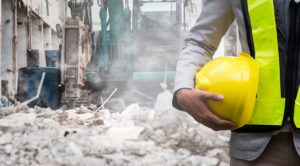Dust Hazards in Construction Meeting Kit

Dust Hazards in Construction Safety Talk
Dust is just one of the many different hazards and dangers that survive and flourish in a construction site. Dust poses health concerns and worries including physical hazards for worker. The issue for worker is to fully understand dust causation and then take the necessary preventative action related to this on-site hazard.
TYPES OF CONSTRUCTION DUST
Construction dust is a generic term for natural minerals or human-made mineral fibers that occur when completing certain construction tasks. There are three types of construction dust:
Silica Dust: A natural mineral, silica exists in common construction materials, including cement, concrete, and mortar. Silica dust occurs once the material undergoes a significant change, such as cutting, drilling, grinding, and sandblasting materials like granite, sand, and sandstone. It’s also known as respirable crystalline silica (RCS). This is the most dangerous type of construction dust.
Non-Silica Dust: Some construction projects don’t have silica present or have silica in minimal amounts, thus resulting in lower toxicity. The material where this type of dust is present includes cement, dolomite, gypsum (plasterboard), limestone, and marble. You tend to find non-silica dust when cutting bricks. Non-silica dust is still harmful to human health, so you should still ensure that you adhere to safety measures.
Wood Dust: This type of dust surfaces when you work mainly on hardwood and softwood. Other wood-based products include chipboard, MDF, and plywood.
DUST HEALTH HAZARDS
Dust that contains crystalline silica is also a huge issue for workers on construction sites. Crystalline silica respirable dust particles can penetrate deep into the lungs and cause disabling and sometimes fatal lung diseases, including silicosis and lung cancer, as well as kidney disease. It is never good to breathe in any excessive of amount of dust even if it is thought that no contaminants are present in it.
Once buildup of scar tissue occurs, it can cause difficulty in breathing and may cause you to develop lung cancer or chronic obstructive pulmonary disorder (COPD).
You may also experience irritation in your eyes, nose, throat, skin and lungs.
BEST AVOIDANCE PRACTICES/PROTOCOLS AT THE WORK SITE
- Protect workers by using personal protective equipment (PPE), including respirators and dust masks.
- The National Institute for Occupational Safety and Health (NIOSH) has approved filtering respirators or dust masks to provide extra breathing protection from dust. Those marked N100/R100/P100 protect you against dust levels up to 10 times the exposure limit.
- Another option to consider is an air-purifying respirator. Although these deal more with gas and vapor, they can protect you from construction dust. The respirator comes with a statement of certification, which signifies what you should use the respirator for and how it can protect you.
- If your work involves being outside, you also need to wear a mask. While the wind has some effect on the dust level created, you may partake in tasks that have you working close to the tools that create the dust.
OTHER MEASURES – CONSTRUCTION DUST CONTROL ON JOBSITE
Several Options Are Available to Minimize Construction Dust At Your Job Site
- One of the best and most inexpensive ways to cut down on dust is to spray the area down with water. For outdoor projects, depending on the weather and the location of the project, you should water the area at least three times per day. Water trucks can help the dirt and dust stay down. Make sure not to overwater the area, as that can cause erosion and runoff.
- Laying down mulch and vegetation is another option, as it controls dust and erosion. After you water the area to get it established, you don’t need to tend to it. Tackifiers also create bonds with seeds and keep them from blowing away. Polymers are another resource that you apply on soil and then spray with water trucks.
Indoor Projects
- With indoor projects, you should always try to barricade off the area or tape down areas to prevent dust from accumulating. Use dust-abatement technology to keep dust levels down, as well as wet saws and dust collectors to keep harmful levels of dust away.
- Negative-air HEPA-filter vacuums offer inward airflow to help prevent dust and other particulates from escaping into the work area. Afterward, air scrubbers capture the contaminated air and then clean it and filter it back into the area.
- Avoid using a broom, as this can cause the dust to remain in the air.
- Daily cleanups are a must to keep the dust from escaping the area.
FINAL WORD
Consider the hazards dust creates onsite. Realize the health issues it can create as well as the physical hazards. Elimination is the best way to protect yourself from dust or any other hazard onsite for that matter.